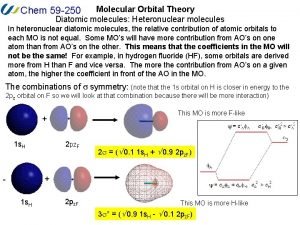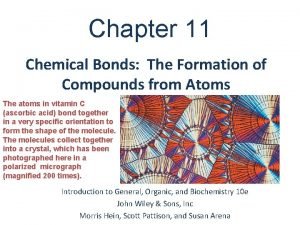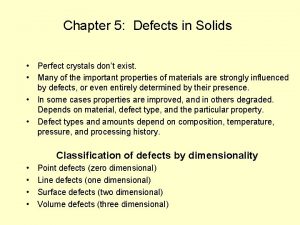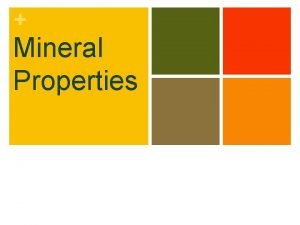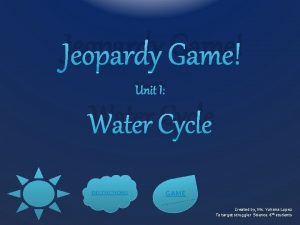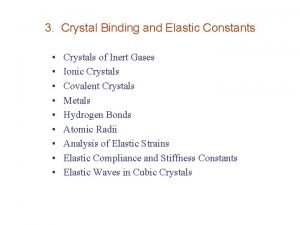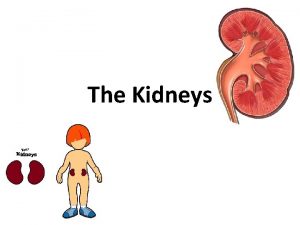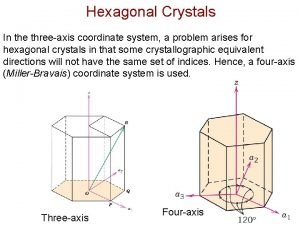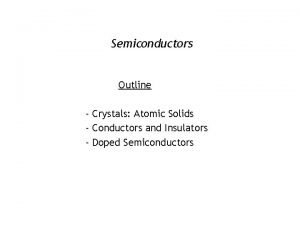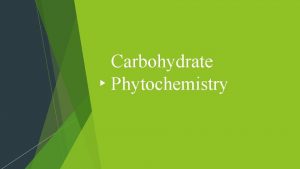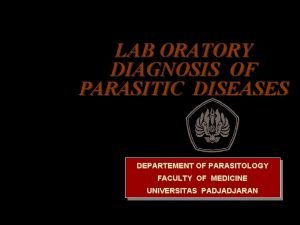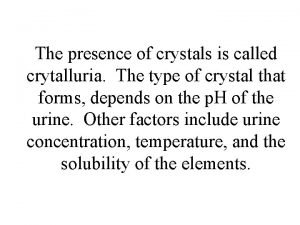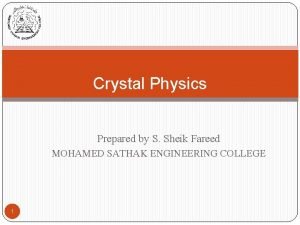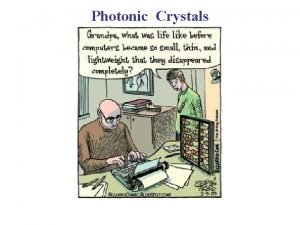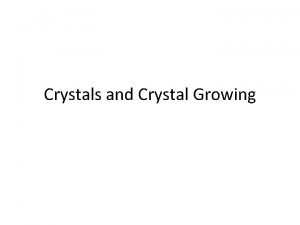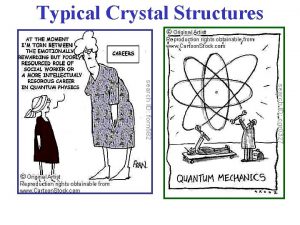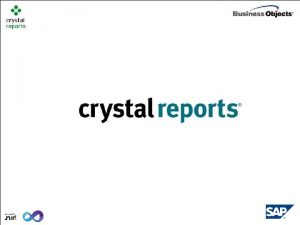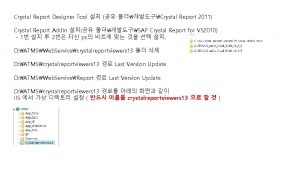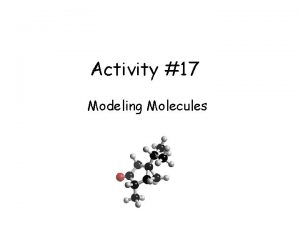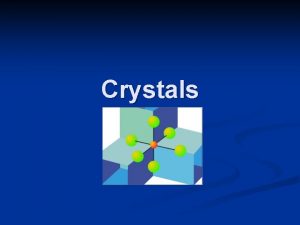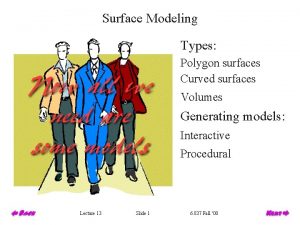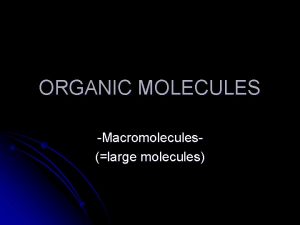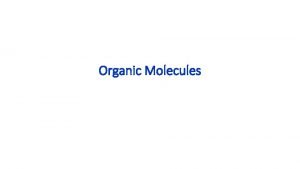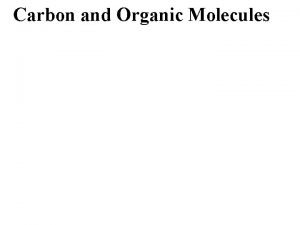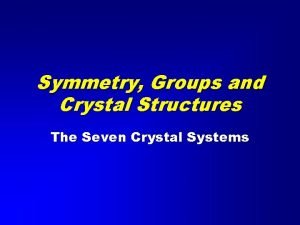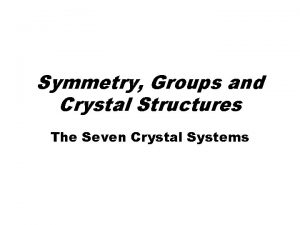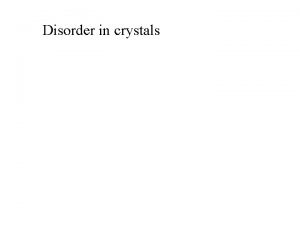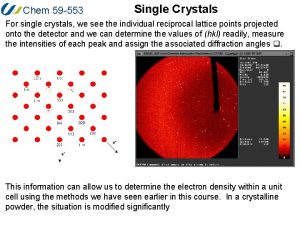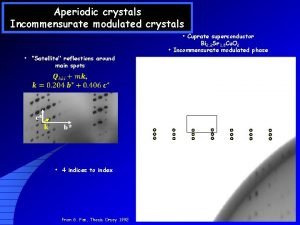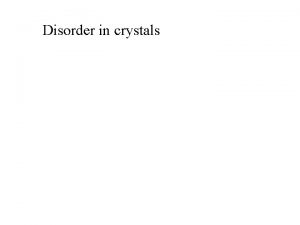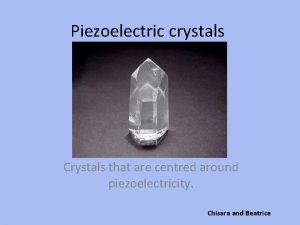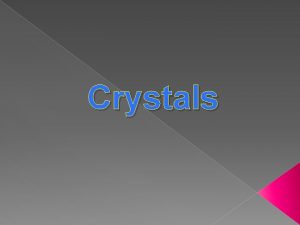Molecular Modeling of Crystal Structures molecules surfaces crystals











![Non-bonded interactions: Van der Waals repulsive: ~r-10 attractive: ~r-6 E=D 0[(r 0/r)12 -2(r 0/r)6] Non-bonded interactions: Van der Waals repulsive: ~r-10 attractive: ~r-6 E=D 0[(r 0/r)12 -2(r 0/r)6]](https://slidetodoc.com/presentation_image_h/1918bbd730a8c42c109446d3438534cf/image-12.jpg)













- Slides: 25

Molecular Modeling of Crystal Structures molecules surfaces crystals

1. Potential energy functions QM ab initio: distribution of electrons over the system. Gaussian 94, Gamess, . . . Semi-empirical methods: pre-calculated values or neglect of some parts of the ab-initio calculation. MOPAC (mopac 6, 7, 93, 2000) Empirical methods: observed/fitted values for interactions between atoms. Sybyl, Cerius 2, Gromos, . . .

Potential energy functions Differences: * Speed (as a function of system size) * Accuracy * Intended use (heat of fusion; conformational energies; transition states; vibrations/spectra; …) * Transferability / applicability * Availability / user interface

Potential energy functions Focus: Molecular Mechanics (MM) “Ball and Spring” model of molecules, based on simple equations giving U as function of atomic coordinates G = U + p. V - TS H = U + p. V EMM = U

Molecular Mechanics system from atoms + bonds EMM = Estretch + Ebend + Etorsion + Evdw + Ecoul +. . . bonded • stretching • bending • torsion H non-bonded H H C C H H H

MM: interactions via bonds r bond stretch Es = 1/2 ks(r-r 0)2 … + C 3(r-r 0)3 + C 4(r-r 0)4 E - True. . modeled via (r-r 0)2 r 0 r

Force field parameters: bond lengths (Dreiding) C Es = 1/2 ks(r-r 0)2 C C C E Bond type r 0 (Å) ks (kcal/mol. A 2) C(sp 3)--C(sp 3)--C(sp 2)--C(sp 2) C(sp 3)--H 1. 53 700 1. 43 700 1. 33 1400 1. 09 700 k. S=700: E=3 kcal ~ r=0. 09Å

MM: interactions via bonds bending Eb = 1/2 kb( - 0)2 E 0

Force field parameters: bond angles (Dreiding) C O H E Angle type 0 (°) X--C(sp 3)--X X--O(sp 3)--X 109. 471 100 104. 510 100 kb(kcal/mol. rad 2) E=3 kcal ~ =14°

Force field parameters: torsion angles (Dreiding) Etor = V 1[1 - cos ( - 01) ] V 2[1 - cos 2( - 02)] V 3[1 - cos 3( - 03)] C E V 3 0 60 120 180 C

Force field parameters: torsion angles (Dreiding) C C torsion type n V (kcal/mol) 0 (°) X--C(sp 3)--X X--C(sp 2)--X 3 1. 0 2 22. 5 180 0
![Nonbonded interactions Van der Waals repulsive r10 attractive r6 ED 0r 0r12 2r 0r6 Non-bonded interactions: Van der Waals repulsive: ~r-10 attractive: ~r-6 E=D 0[(r 0/r)12 -2(r 0/r)6]](https://slidetodoc.com/presentation_image_h/1918bbd730a8c42c109446d3438534cf/image-12.jpg)
Non-bonded interactions: Van der Waals repulsive: ~r-10 attractive: ~r-6 E=D 0[(r 0/r)12 -2(r 0/r)6] (Lennard-Jones) E=D 0{exp[a(r 0/r)]-b(r 0/r)6} (Buckingham; “exp-6”)

Non-bonded interactions: Coulomb (electrostatic) atomic partial charges: + + - Eij=(qixqj)/( rij) + + atomic/molecular multipoles: E= ix j/Dr 3

additional energy terms in force fields * out-of-plane energy term * Hydrogen bond energy term

MM energy calculation EMM = Estretch + Ebend + Etorsion + Evdw + Ecoul +. . . bonded 1 non-bonded 5 2 3 4 6 7 bonded non-bonded 1… 2 1… 3 1… 4: scaled 1… 5 1… 6/7/8 8

Some available force fields FF software Gromos Charmm; Quanta Amber Tripos Sybyl Dreiding Cerius Compass Cerius CVFF Cerius Glass 2. 01 Cerius focus bio bio general ionic

Force field parameters: where do they come from? 1. Mimic physical properties of individual elements or atom types, producing a “physical” force field. Properties can be taken from experimental data, or ab-initio calculations. Examples: Dreiding, Compass. + outcome will be ‘reasonable’, predictable; extension to new systems relatively straightforward. - performance not very good.

Force field parameters: where do they come from? 2. Optimize all parameters with respect to a set of test data, producing a “consistent” force field. Test set can be chosen to represent the system under investigation. Examples: CFF, CVFF. + outcome often good for a particular type of systems, or a particular property (e. g. IR spectrum). - extension to new systems can be difficult; no direct link to ‘physical reality’

Force field parameters: where do they come from? 3. Apply common sense and look at what the neighbors do. Examples: Gromos. + does not waste time on FF parameterization; resonable results. -?

Atomic charges Why? To include the effect of the charge distribution over the system. Some sp 2 oxygens are more negative than others. How? Assign a small charge to each atom. Caveat: interaction with other force field parameters (e. g. Vd. W).

Atomic charges What is the atomic charge? * Based on atomic electronegativity, optimized for a given FF. example: Gasteiger charges. • Based on atomic electronegativity and the resulting electrical field. example: Charge Equilibrium charges (QEq). * Based on the electronic distribution calculated by QM. example: Mulliken charges. * Based on the electrostatic potential near the molecule, calculated by a non-empirical method (or determined experimentally). examples: Chelp, Chelp. G, RESP.

Atomic charges Properties and features of different charge schemes: * Depends on molecular conformation? * Easy (=quick) to calculate? * Performance in combination with force field? Known-to-be-good combinations: Tripos -- Gasteiger Dreiding -- ESP Compass -- Compass

Atomic charges: charges fitted to the Electro. Static Potential (ESP) mechanism: Coulomb interactions result from the electrostatic potential around a molecule. + + + H - -- O -- + H + + H+

Atomic charges: charges fitted to the Electro. Static Potential (ESP) molecule QM wave function electron density sample point H O H sample true ESP mathematical fit atomic charges that reproduce the true ESP for each sample point: atomsq/ r= ESPQM * atomic q as variables

Atomic charges: charges fitted to the Electro. Static Potential (ESP) Properties and features of different fitting schemes: * Number of sample points. * Position of sample points. * Additional restraints (e. g. all q. H in CH 3 equal). * Fitting to multiple conformations. Known-to-be-good fitting schemes: Chelp. G RESP
 Organic molecules vs inorganic molecules
Organic molecules vs inorganic molecules Molecular orbital diagram of heteronuclear diatomic
Molecular orbital diagram of heteronuclear diatomic Modeling role modeling theory
Modeling role modeling theory Relational modeling vs dimensional modeling
Relational modeling vs dimensional modeling Bead like structures formed by dna and histone molecules
Bead like structures formed by dna and histone molecules Physical state of covalent compounds
Physical state of covalent compounds Ionic covalent metallic
Ionic covalent metallic Zinc oxide + nitric acid → zinc nitrate + water
Zinc oxide + nitric acid → zinc nitrate + water Common molecular structures
Common molecular structures Cool molecular structures
Cool molecular structures Shapes of simple molecules
Shapes of simple molecules Lewis structures and molecular geometry
Lewis structures and molecular geometry Homologous structures definition
Homologous structures definition Point defects in crystals
Point defects in crystals Are crystals pure substances
Are crystals pure substances Quaporation
Quaporation Crystals for binding
Crystals for binding Proteinoria
Proteinoria Sugar crystals experiment conclusion
Sugar crystals experiment conclusion Hexagonal coordinate system
Hexagonal coordinate system Pauli crystals
Pauli crystals Fibrenoma
Fibrenoma Identification test for tragacanth
Identification test for tragacanth Charcot leyden crystals parasites
Charcot leyden crystals parasites Crytalluria
Crytalluria Point defects in crystals
Point defects in crystals

